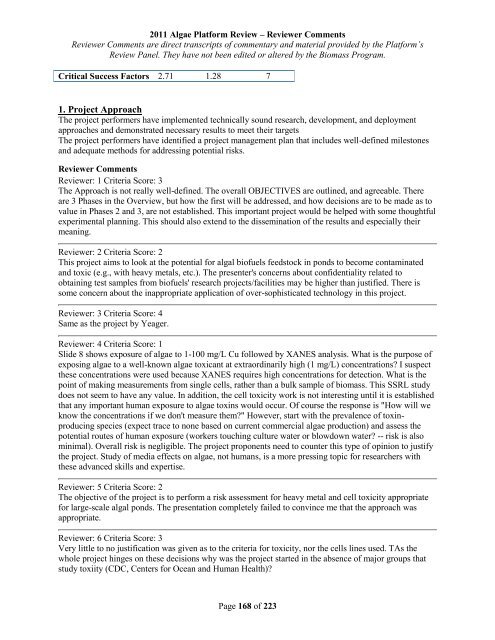Reviewer Comments - EERE
Reviewer Comments - EERE
Reviewer Comments - EERE
Create successful ePaper yourself
Turn your PDF publications into a flip-book with our unique Google optimized e-Paper software.
2011 Algae Platform Review – <strong>Reviewer</strong> <strong>Comments</strong><br />
<strong>Reviewer</strong> <strong>Comments</strong> are direct transcripts of commentary and material provided by the Platform’s<br />
Review Panel. They have not been edited or altered by the Biomass Program.<br />
Critical Success Factors 2.71 1.28 7<br />
1. Project Approach<br />
The project performers have implemented technically sound research, development, and deployment<br />
approaches and demonstrated necessary results to meet their targets<br />
The project performers have identified a project management plan that includes well-defined milestones<br />
and adequate methods for addressing potential risks.<br />
<strong>Reviewer</strong> <strong>Comments</strong><br />
<strong>Reviewer</strong>: 1 Criteria Score: 3<br />
The Approach is not really well-defined. The overall OBJECTIVES are outlined, and agreeable. There<br />
are 3 Phases in the Overview, but how the first will be addressed, and how decisions are to be made as to<br />
value in Phases 2 and 3, are not established. This important project would be helped with some thoughtful<br />
experimental planning. This should also extend to the dissemination of the results and especially their<br />
meaning.<br />
<strong>Reviewer</strong>: 2 Criteria Score: 2<br />
This project aims to look at the potential for algal biofuels feedstock in ponds to become contaminated<br />
and toxic (e.g., with heavy metals, etc.). The presenter's concerns about confidentiality related to<br />
obtaining test samples from biofuels' research projects/facilities may be higher than justified. There is<br />
some concern about the inappropriate application of over-sophisticated technology in this project.<br />
<strong>Reviewer</strong>: 3 Criteria Score: 4<br />
Same as the project by Yeager.<br />
<strong>Reviewer</strong>: 4 Criteria Score: 1<br />
Slide 8 shows exposure of algae to 1-100 mg/L Cu followed by XANES analysis. What is the purpose of<br />
exposing algae to a well-known algae toxicant at extraordinarily high (1 mg/L) concentrations? I suspect<br />
these concentrations were used because XANES requires high concentrations for detection. What is the<br />
point of making measurements from single cells, rather than a bulk sample of biomass. This SSRL study<br />
does not seem to have any value. In addition, the cell toxicity work is not interesting until it is established<br />
that any important human exposure to algae toxins would occur. Of course the response is "How will we<br />
know the concentrations if we don't measure them?" However, start with the prevalence of toxinproducing<br />
species (expect trace to none based on current commercial algae production) and assess the<br />
potential routes of human exposure (workers touching culture water or blowdown water? -- risk is also<br />
minimal). Overall risk is negligible. The project proponents need to counter this type of opinion to justify<br />
the project. Study of media effects on algae, not humans, is a more pressing topic for researchers with<br />
these advanced skills and expertise.<br />
<strong>Reviewer</strong>: 5 Criteria Score: 2<br />
The objective of the project is to perform a risk assessment for heavy metal and cell toxicity appropriate<br />
for large-scale algal ponds. The presentation completely failed to convince me that the approach was<br />
appropriate.<br />
<strong>Reviewer</strong>: 6 Criteria Score: 3<br />
Very little to no justification was given as to the criteria for toxicity, nor the cells lines used. TAs the<br />
whole project hinges on these decisions why was the project started in the absence of major groups that<br />
study toxiity (CDC, Centers for Ocean and Human Health)?<br />
Page 168 of 223




